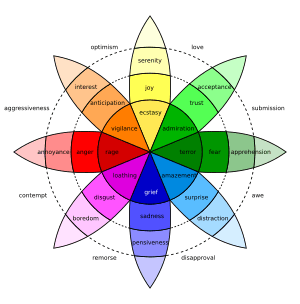Robert Plutchik facts for kids
Quick facts for kids
Robert Plutchik
|
|
|---|---|
 |
|
| Born | October 21, 1927 |
| Died | April 29, 2006 (aged 78) |
| Nationality | American |
| Occupation | psychologist |
| Spouse(s) | Anita Plutchik |
| Children | Lori Plutchik, Lisa Silva, Roy Plutchik |
Robert Plutchik (born October 21, 1927 – died April 29, 2006) was a smart American psychologist. He taught at the Albert Einstein College of Medicine and the University of South Florida. He earned his Ph.D. from Columbia University.
Dr. Plutchik wrote over 260 articles, 45 chapters, and eight books. He also edited seven books! He was very interested in studying emotions, how people behave, and how therapy helps.
Understanding Emotions
Robert Plutchik had a cool idea about emotions! He thought there were eight main, or primary, emotions that everyone feels. These are:
- anger
- fear
- sadness
- disgust
- surprise
- anticipation (that's like looking forward to something)
- trust
- joy
Plutchik believed these emotions help us survive. For example, fear makes us want to run away or fight, which keeps us safe from danger.
He also had some important ideas about emotions:
- Emotions are important for all living things, from animals to humans.
- Emotions have changed over time to help different animals survive.
- There are a few basic emotions that are like building blocks.
- Other emotions are just mixtures of these basic ones.
- Emotions can be opposite, like joy and sadness.
- Emotions can be felt with different strengths, from mild to very strong.
Plutchik's Wheel of Emotions
Dr. Plutchik created a special wheel of emotions to show how different feelings are connected. He first shared this idea in 1980.
He suggested that the eight primary emotions come in pairs of opposites:
- joy versus sadness
- anger versus fear
- trust versus disgust
- surprise versus anticipation
His wheel is a bit like a color wheel. Just like colors, primary emotions can be felt at different strengths. They can also mix together to create new, more complex emotions. For example, joy and trust can mix to create love!
Plutchik also thought that our emotions are linked to how we protect ourselves, which are called defense mechanisms. He believed that the eight main emotions were connected to eight ways we defend ourselves.
Here's a simple way to think about how emotions work:
| What Happens | What You Think | What You Feel | What You Do | The Result | |
|---|---|---|---|---|---|
| Something scary | "Danger!" | Fear, terror | Run away, hide | You are safe | |
| Something blocks you | "Enemy!" | Anger, rage | Fight, hit | You remove the problem | |
| Meeting someone special | "I want to be with them!" | Joy, ecstasy | Be friendly, connect | You make new connections | |
| Losing someone important | "I'm alone!" | Sadness, grief | Cry for help | You get comfort | |
| Being with friends | "They are my friends!" | Acceptance, trust | Share, help | You belong to a group | |
| Seeing something gross | "It's bad!" | Disgust, loathing | Push away, avoid | You stay healthy | |
| Exploring new places | "What's next?" | Anticipation | Look around, plan | You discover new things | |
| Something sudden happens | "What was that?" | Surprise | Stop, pay attention | You learn something new |
Publications
Dr. Plutchik wrote the article about "Emotions" for the World Book Millennium 2000 encyclopedia.
See also
 In Spanish: Robert Plutchik para niños
In Spanish: Robert Plutchik para niños


